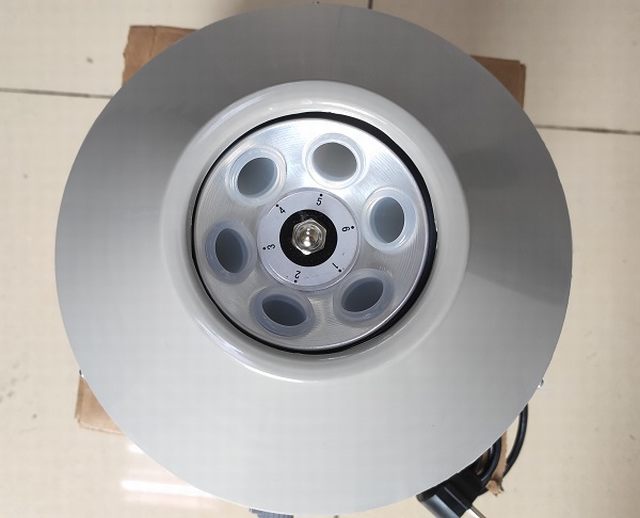Use Care And Maintenance Of Centrifuge
Centrifuge is a common tool in laboratory, mainly used to separate the solid phase and liquid phase in colloidal solution. By using high-speed swirling method, each particle in the centrifuge tube gets an acceleration, the density of the solid is greater than that of the liquid. Solid-liquid separation. Centrifuges are widely used in chemistry, petroleum, food, pharmaceutical, beneficiation, coal, water treatment and shipbuilding sectors.


When using a laboratory centrifuge, the weight of the sample cannot exceed the weight that the centrifuge can withstand, and the sample should be evenly placed in the correct place, so as prolong life-span of the centrifuge. The centrifuge needs to be regularly checked. For maintenance, it usually takes 6 months as a period. It is also necessary to check whether the internal equipment of the laboratory centrifuge has been worn and loosened. If the wear is serious, the centrifuge should be repaired before operation.
1. The laboratory centrifuge should be placed on stable table when it is used. The base of the laboratory centrifuge is equipped with rubber suction feet, which is closely attached to the table by means of atmospheric pressure and the weight of the instrument itself. Large-capacity low-speed centrifugation The machine and high-speed refrigerated centrifuge should be placed on solid ground and placed horizontally. Large-capacity laboratory centrifuge weighs hundreds of kilograms should be placed on very solid floors and dust-proof and moisture-proof equipment to ensure the centrifuge room A certain degree of vacuum is reached for normal operation. A safe distance must be maintained around the laboratory centrifuge, and no dangerous objects should be stored near the centrifuge.
2. Selects a suitable rotor and controls the speed of the rotor. The speed setting must not exceed the maximum speed, and the laboratory low-speed centrifuge is no exception.
3, The laboratory centrifuge should reduce the maximum speed of the rotor under the following conditions
A, when the operating time and number of rotations of the rotor reach the specified life,
B, when the rotor is damaged by local surface or slight corrosion in the tube hole,
C, when using stainless steel centrifuge tubes, sleeves, thick-walled tubes or centrifuge bottles,
D, when the average density of the sample exceeds 1.2g / cm3, when the rotor is exposed to high temperature.
4. Before each operation, the rotor must be strictly checked if foreign matter and dirt are in the hole, leading to imbalance.
A, The rotor must be kept clean and dry without collision and abrasion. If it is accidentally dropped, X-ray film inspection of the rotor should be performed to confirm that there is no internal damage before continuing to use,
B, The rotor should be soaked and washed with warm water (0 ℃ - 60 ℃) and neutral detergent after each use. Rinse with distilled water or deionized water after wiping, wipe with a soft cloth and dry with a hair dryer. Ten, wax, ten Save dry.
5.The tensile strength and elongation of various laboratory centrifuge tubes are different, and should be selected as required.
A, Centrifuge tubes can be made of many different materials, such as polyethylene, cellulose, polycarbonate, polypropylene, etc. When using, pay attention to ensure that samples, solvents and gradient materials do not corrode the centrifuge tube and cover components,
B, Expired, aged, cracked or corroded centrifuge tubes should not be used or slowed down.
C, control the use times of plastic branch centrifuge tubes, pay attention to specifications.
6, centrifugal tubes need to be placed symmetrically, and the sample must be perfused in equal amounts. Note that the centrifuge tube should only be filled with 70%,
Although the laboratory high-speed centrifuge has a lid, the sample may leak due to the strong centrifugal force. Most of the centrifuge tubes are attached with a lid. Note that the lid of the centrifuge tube must also be balanced together. Do not make the rotor unbalanced. It is best not to run the laboratory centrifuge for more than 60 minutes at a time.
7.If abnormal phenomena are found during centrifugation, such as abnormal noise and vibration, you should immediately stop the inspection by pressing STOP (not power off), and do not continue to run until the cause is found.
8. During the use of the instrument, a machine failure occurs, and technical personnel should be contacted in time when the components are damaged. During the operation of the laboratory centrifuge, do not open the centrifuge chamber cover, and do not hit the rotating rotor and the rotating rotor with your hands or foreign objects.
9, Centrifuge tube, do not bump or move the centrifuge, or lean on, sit on the centrifuge.
10.When the centrifugation is completed, wait until the centrifuge is completely stationary before opening the hatch, and take out the centrifuge tube as soon as possible. First observe whether the centrifuge tube is completely sedimented and the sedimentation position. Regardless of whether the upper layer or the sediment is desired, please take the net Only the supernatant should be collected in the beaker to avoid mistakes. Be careful when dumping the supernatant to prevent the sediment from pouring out together: if you accidentally mix it together, you must repeat it. If there is a leak in the centrifuge tube, find out the reason and clean the centrifuge as soon as possible Cavity or centrifuge.
11.After using the laboratory centrifuge, do a good job of cleaning and keep the machine clean.
 Espanol
Espanol English
English



